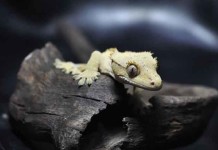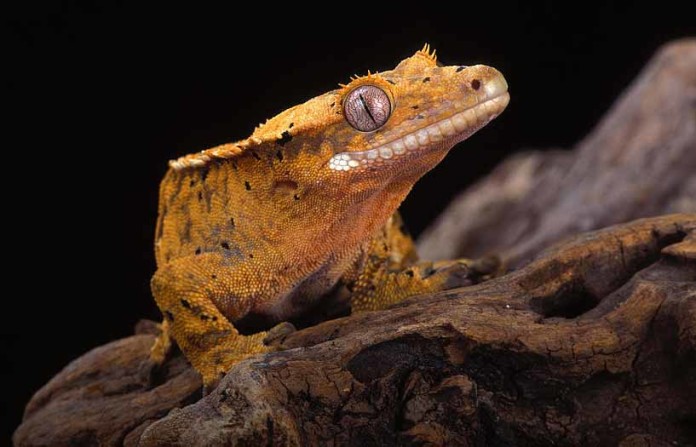The crested gecko habitat can be as simple or as elaborate as you choose. A simple habitat is best for hatchlings in order for them to easily find their food and allow you to observe them to ensure proper shedding. Once they have matured, a more natural enclosure can be good for the gecko and more aesthetically appealing.
Temperature and Humidity
An average temperature between 70°F and 80°F is suitable for the crested gecko. To ensure proper humidity and hydration for the crested gecko, it is best to mist the enclosure each night and allow it to evaporate during the day. Hatchling geckos require more hydration for proper shedding. As they grow older, you can let the enclosure dry out completely periodically to ensure that it does not breed mold and mildew. Proper ventilation is an essential part of this; therefore, a screen top is best.
Cleanliness
Cleanliness is vitally important to the health of your crested gecko. The habitat should be kept free of waste and should be wiped down frequently. A thorough cleaning of the tank should be completed weekly, where the tank and its contents are scrubbed and rinsed well. Fresh substrate should then be added.
Height Most Important
When housing a crested gecko, the height of the enclosure is more important than depth. The gecko is an arboreal animal and likes to climb. Providing plants and limbs on which they can climb will help geckos thrive in their captive habitat.
Hides
 The crested gecko will feel more secure in a habitat that has a large amount of foliage. They come from areas of dense forest in their natural habitat and are used to the cover of live plants and trees. You can provide this by using artificial plants of silk or plastic, or you can plant live specimens within a soil substrate and in pots. Be sure to use non-toxic plants that have been washed clean of any pesticides. Ficus and pothos are both good choices.
The crested gecko will feel more secure in a habitat that has a large amount of foliage. They come from areas of dense forest in their natural habitat and are used to the cover of live plants and trees. You can provide this by using artificial plants of silk or plastic, or you can plant live specimens within a soil substrate and in pots. Be sure to use non-toxic plants that have been washed clean of any pesticides. Ficus and pothos are both good choices.
Substrate
The substrate can be something as simple as paper towels or you can use peat, reptile carpet, coconut fiber or potting soil. Be careful when choosing a substrate, as the gecko can ingest it when feeding. Peat is a good choice, for it is rarely dangerous to the gecko if ingested and is organic. Paper towels are best to use with hatchlings.
The crested gecko habitat is easy to set up and maintain. It is important that it is cleaned frequently and that the gecko feels secure in its environment. It will take a few days to a week for the new crested gecko to acclimate to its new habitat. Observe the gecko and refrain from handling it until it becomes comfortable in its new environment.












